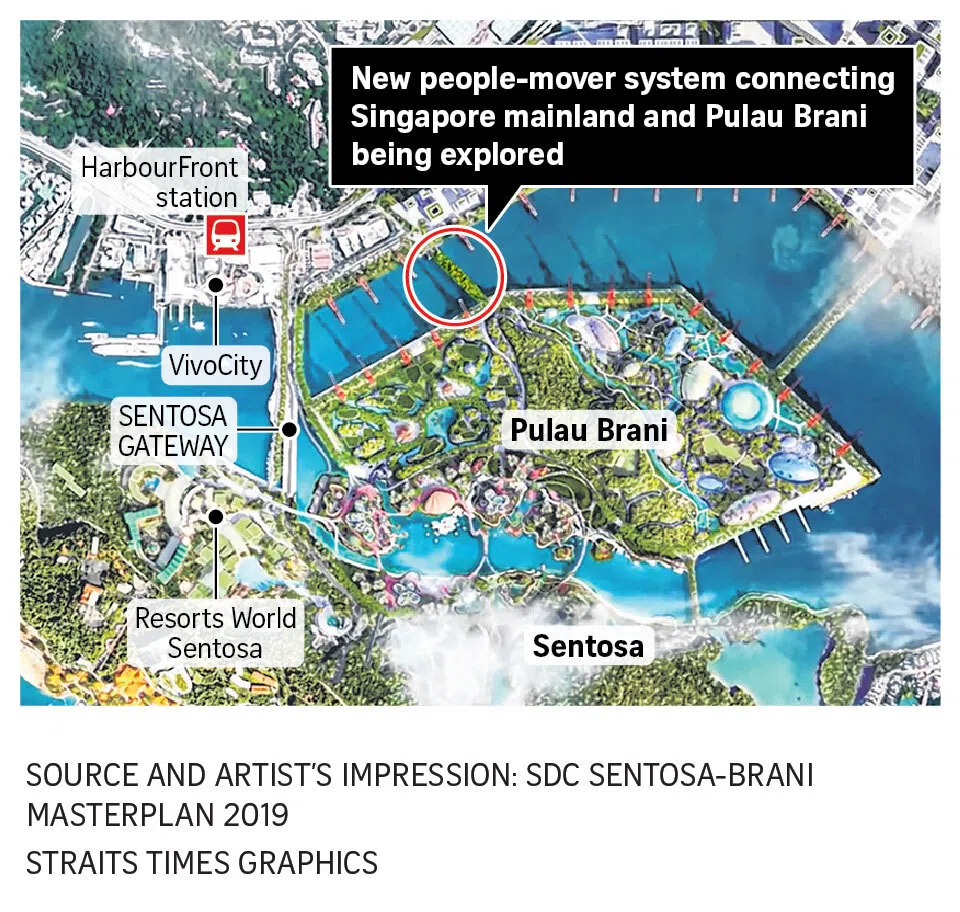New link for travel between Pulau Brani and mainland Singapore under study
Sign up now: Get ST's newsletters delivered to your inbox

The Greater Sentosa Master Plan involves redeveloping Sentosa and Pulau Brani into a tourist destination over the next two to three decades.
ST PHOTO: CHONG JUN LIANG
Follow topic:
- SDC plans a people-mover system between Pulau Brani and mainland Singapore via a Keppel Link bridge to improve accessibility, according to GeBiz tender documents.
- The system will support the Greater Sentosa Master Plan to redevelop Sentosa and Pulau Brani into a tourist destination after the Brani Terminal relocates by 2027.
- A feasibility study aims to assess transport options complementing existing infrastructure. Expert Raymond Ong suggests assessing travel demand and having a "wow factor" system.
AI generated
SINGAPORE – The Sentosa Development Corporation (SDC) is exploring a new people-mover system that will run between Pulau Brani and mainland Singapore.
A people-mover system refers to a transit system, such as the Sentosa Express monorail service that links VivoCity shopping complex with the resort island.
Based on tender documents published on government procurement portal GeBiz on Oct 24, SDC is seeking consultancy services to conduct a feasibility study for the “conceptual planning” of a people-mover system along a new bridge, Keppel Link, that will connect mainland Singapore and the west of Pulau Brani.
In response to queries from The Straits Times, SDC said on Nov 17 that it will be exploring “innovative transportation solutions” to improve accessibility and visitors’ experience as part of efforts to enhance connectivity under the Greater Sentosa Master Plan.
Previously known as the Sentosa-Brani Master Plan, announced in 2019
The Brani Terminal, run by port operator PSA, makes up a large part of Pulau Brani. It will fully relocate to the new Tuas megaport
The island also houses the Police Coast Guard’s headquarters.
Pulau Brani is sandwiched between the south of mainland Singapore and Sentosa, and is about 340m away from Keppel Harbour, according to national map service OneMap.
SDC said the “high-level” feasibility study is meant to assess the various options that could complement its existing transport infrastructure.
According to the masterplan, the eastern part of Pulau Brani will be home to the Waterfront zone, while its central portion will house the Ridgeline zone, which will connect green spaces and feature nature and heritage attractions.
To the west of the island, there will be the Vibrant Cluster – with large-scale attractions spanning both Sentosa and Pulau Brani – and a lifestyle and commercial zone, Island Heart, where hotels, conference spaces, dining options and shops will be located.
In his National Day Rally speech in 2019, then Prime Minister Lee Hsien Loong had said a Downtown South resort was likely to be built on Pulau Brani.
These redevelopment plans were later shelved temporarily because of the Covid-19 pandemic Sentosa Sensoryscape attraction
Artist’s impressions from a publicity video released by SDC in 2019 showed an above-ground people-mover system in the Island Heart zone of Pulau Brani, connecting visitors to the beachfront and other spots across the island. No other details about such a transport system were provided then.
The tender will close at 4pm on Dec 5, after an extension to the original Nov 21 deadline.

Associate Professor Raymond Ong, a transport infrastructure researcher at NUS’ department of civil and environmental engineering, said a new people-mover system will be essential if Pulau Brani becomes a tourist destination.
At present, he said, there is only one route to enter Pulau Brani from mainland Singapore, via Brani Terminal Avenue.
This could cause congestion, lengthening the time taken for tourists and other travellers to get to the island, which could affect their experience.
Prof Ong said a people-mover system, which can accommodate more passengers than cars, but fewer than a wide-scale rail service such as the MRT, will be suitable for the number of potential visitors to Pulau Brani.
But the definition of a people-mover system is broad, as it could refer to driverless buses or Changi Airport’s Skytrain, or even something as simple as a travelator, he added.
What this feasibility study should aim to do is study the potential travel demand from tourists and visitors to Pulau Brani, said Prof Ong, so that SDC can identify the correct scale for the system it is looking at.
“And as a tourist attraction, the experience is important – the system should give tourists the ‘wow factor’,” he added.


